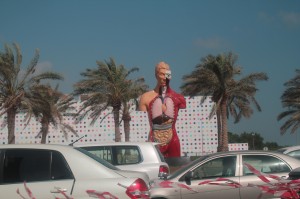Today I was stuck in Doha traffic for so long, it made me question whether my expedition (from VCUQ to the Damien Hirst exhibition at the Al Riwaq exhibition space) would be worth the privations of my seemingly interminable journey. As it turned out, the Hirst exhibition (even with its hundreds of tons of shark meat transported by the Qatar Emiri Air Force, thousands of British fly larvae flown from London seated in business class, and millions of dollars of diamonds) was not as valuable as the time my driver and I spent in inexplicable gridlock. A stunning exhibition at the Museum of Islamic Art about the history of the Hajj pilgrimage to Mecca, however, was certainly worth joining the slow caravan of impotent land cruisers that inched its way down Khalifa Street, and reminded me of what a truly long and treacherous journey might have felt like. While today, pilgrims can fly to Jeddah airport with relative ease, prior to 1981, the journey to the Ka’ba for Muslims all across the Islamic world was an extreme test of physical and spiritual endurance. Prospective pilgrims would clear all their debts and make a will before they left, in expectation of succumbing to the one of the many threats to their progress and even their life, such as extremities of temperature, lack of water or food, sandstorms, disease, and banditry.
By comparison, of course, traversing Doha at 9:30 on a Sunday morning, in the midst of a new eruption of road construction, is a breeze. And to compare so sacred a journey as the once-in-a-lifetime Hajj with one so banal as the daily commute, is probably profane in itself, but if you’ll permit me the license of an ill-informed visitor to the region, I wonder if there are elements of the pilgrimage that might inform a re-imagining of transportation in Doha?
As is well-known to residents, the issues that contribute to the increasingly severe traffic congestion in Doha today, include: increased road construction in preparation for FIFA 2022; the region-wide policy of subsidizing car fuel; the absence of High Occupancy Vehicle lanes, bus lanes, let alone bicycle lanes; and the lack of toll zones. The Doha Metro system, currently under construction, may (or may not) be open in 2026. For the purposes of today’s provocation, however, let’s set aside practicalities, and imagine a possible future of commuting in Doha, inspired by the region’s doughty pilgrim ancestors. How about a ride on a colorful dhow, decked out with wifi, up a central canal leading from the harbor up Al Rayyan Road to Education City? Once you alight, there are bikes (step-throughs to accommodate abayas) waiting on the towpath to ride to VCUQ. Or if you live closer, maybe you’ll opt for a seat inside a beautifully decorated mahmal, atop a camel, strutting down the camel lane?
PROVOCATION #6: How would you like to travel to school tomorrow? What would happen on your journey? Who would you speak to? What would you see?

As much as I would like to idealize the commute – public transportation with the morning paper or, better still, my bicycle and the fresh air – the reality of place (and temperature), distance (drop-offs at school and then VCUQ), and especially vocation (carrying 25 sheets of PVC on the back of a bike isn’t really so feasible) make me fairly content with my current mode of transport. Some NPR, some random acts of traffic kindness to offset the “I will crush you” moments, and I am all good. I do truly miss the oxymoronic commutes of NYC – both intensely hermetic and public at the same time – and I find myself seeking that experience out whenever I travel; but right here, right now, I don’t have any complaints. Just don’t schedule me for a meeting in West Bay in the morning . . .
Osmosis – I’d like to transcend across the throng of jam-jars through assimilating and passing through vehicles. During each pass-through I would absorb a meme/ mnemonic morsel from each automobile, van, truck, delivery-moped traversed. A Situationist derive of stored, disconnected, but contextually interlinked fragments of recollections, digested and re-consituted into an alternate narrative of assumed meanings, limbic impulses and scattered impressions…